The Pinochle family of card games are a hybrid group that involves both melding and the taking of tricks.
Since Three hand Pinochle (also called Auction Pinochle) is one of the most popular, this will be described first. Other variations of Pinochle will be detailed in the variations section below.
Auction Pinochle is played by three players using a special 48 card Pinochle deck. The deck consists of two cards of each standard suit in the following denominations: A, K, Q, J, 10 and 9. The rank of these denominations in all versions of Pinochle is as follows, from high to low: A, 10, K, Q, J, 9.

To determine the first dealer, each player should cut a card from the deck which has been laid face down on the table. The player drawing the lowest card becomes the first dealer. The player drawing the second lowest sits to the dealers immediate left and the remaining player sits to that players left.
The dealer then thoroughly shuffles the cards and offers the deck to the player at his right to cut the deck. After the cut, the dealer deals the cards clockwise around the table, starting with the player to his immediate left. The cards are distributed in packets of three face down cards at a time. After he has distributed the first packet of cards to each player (including himself) he then deals a three card face-down "widow" to the center of the table. He then deals additional rounds of three card batches to each player until each player has 15 cards.
After the players pick up their dealt cards and examined their hands, the bidding phase of the game begins.
Bidding:
The player to the dealers immediate left is the first player to bid. Each player must bid or pass. The minimum starting bid is 200. When bidding a player must bid at least 10 points higher than the last highest bid or pass. Once a player passes, he may make no further bids in this hand and must pass each time it would be his normal opportunity to bid for the remainder of the bidding round. Once there have been two consecutive passes the bidding ends with the high bidder playing the hand as the "bidder". A player is basically bidding the total number of points (or higher) he believes he can score in melds and trick points in the play of the hand.
If all three players pass before an opening bid is made this hand is not played and all the cards are shuffled together and the deck passes to the next player in turn to deal.
Once a player becomes the high bidder, he will then attempt to score at least as many points in melds and trick points as he bid. The two opponents attempt to prevent him from doing this, in a sense becoming temporary partners for the duration of the hand.
Once the "bidder" is determined, this player immediately turns over the three card widow in the center of the table such that all players can see its contents. After all have seen these cards the high bidder adds them to his hand and is then given the opportunity to meld.
Melding:
The high bidder now places his cards in various groups, face up in the center of the table as melds. The bidder is the only player who may thus meld. The following is a list of the possible melds the bidder can thus make and the score for that particular meld:
|
|
|
| Category | Meld | Description | Score |
|---|
| A | Flush | A,10,K,Q,J of the trump suit | 150 |
| A | Royal Marriage | King and Queen of trump suit | 40 |
| A | Common Marriage | King and Queen of same suit (non trump) | 20 |
| A | Deece (sometimes called Dix) | 9 of trump suit | 10 |
| B | 100 Aces | One Ace in each suit | 100 |
| B | 80 Kings | One King in each suit | 80 |
| B | 60 Queens | One Queen in each suit | 60 |
| B | 40 Jacks | One Jack in each suit | 40 |
| C | Pinochle | Queen of spades and Jack of Diamonds | 40 |
|
As there are two identically ranked cards of each suit, the bidder may be able to create two of the same meld and score individually for both.
A player may use the same card in melds from two different categories, but may not use the same card in two melds from the same category. For example, a player could not use the same king in both a flush and a royal marriage, but could use the king in both a flush and 80 kings.
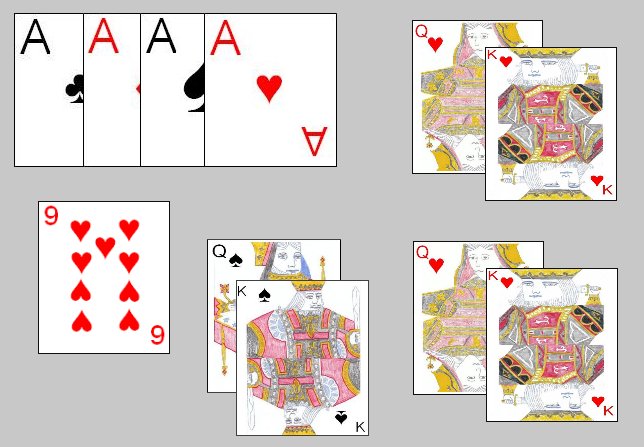 |
|
Melding ExampleAs an example, with hearts as trump the bidders meld might consist of the following:
- 100 Aces - 100 points
- Royal Marriage - 40 points
- Second Royal Marriage - 40 points
- Common Marriage - 20 points
- Dix - 10 points
This would gain the bidder a potential total of 210 points for his melds.
|
After laying the melds on the table, the total points are then notated and are used to help this player obtain their bid. If the melding score is already enough to fulfill or surpass their bid, that player instantly wins the hand, scoring appropriately. However, the player, after determining his meld score and examining his hand may concede (give up) the hand (not believing they can earn enough additional points from winning tricks to make their bid). If the bidder does concede, the hand immediately ends with the opponents declared the winners of the hand. These opponents each earn "game points" as given in the "Game Points" table below.
If the bidder does not concede, after laying his melds down, he then declares the trump suit (which is usually self-evident from the melds laid to the table) he chooses for this hand and discards any three cards remaining in his hand while his melds are still displayed (this is called burying). These three cards are laid face down in front of the bidder as they will be
totaled in for the bidder when determining the bidders trick point scoring at the end of the hand.
The bidder may not discard any card used in an active meld. The discard is mandatory and could potentially mean the bidder might have to break apart a meld. After this, the bidder then picks up all his melded cards from the table adding them back into his hand for the trick taking phase of the hand.
Play of the Hand:
The next phase of the game is called the trick taking portion of the hand, and consists of the players playing cards to a series of tricks in order to win tricks.
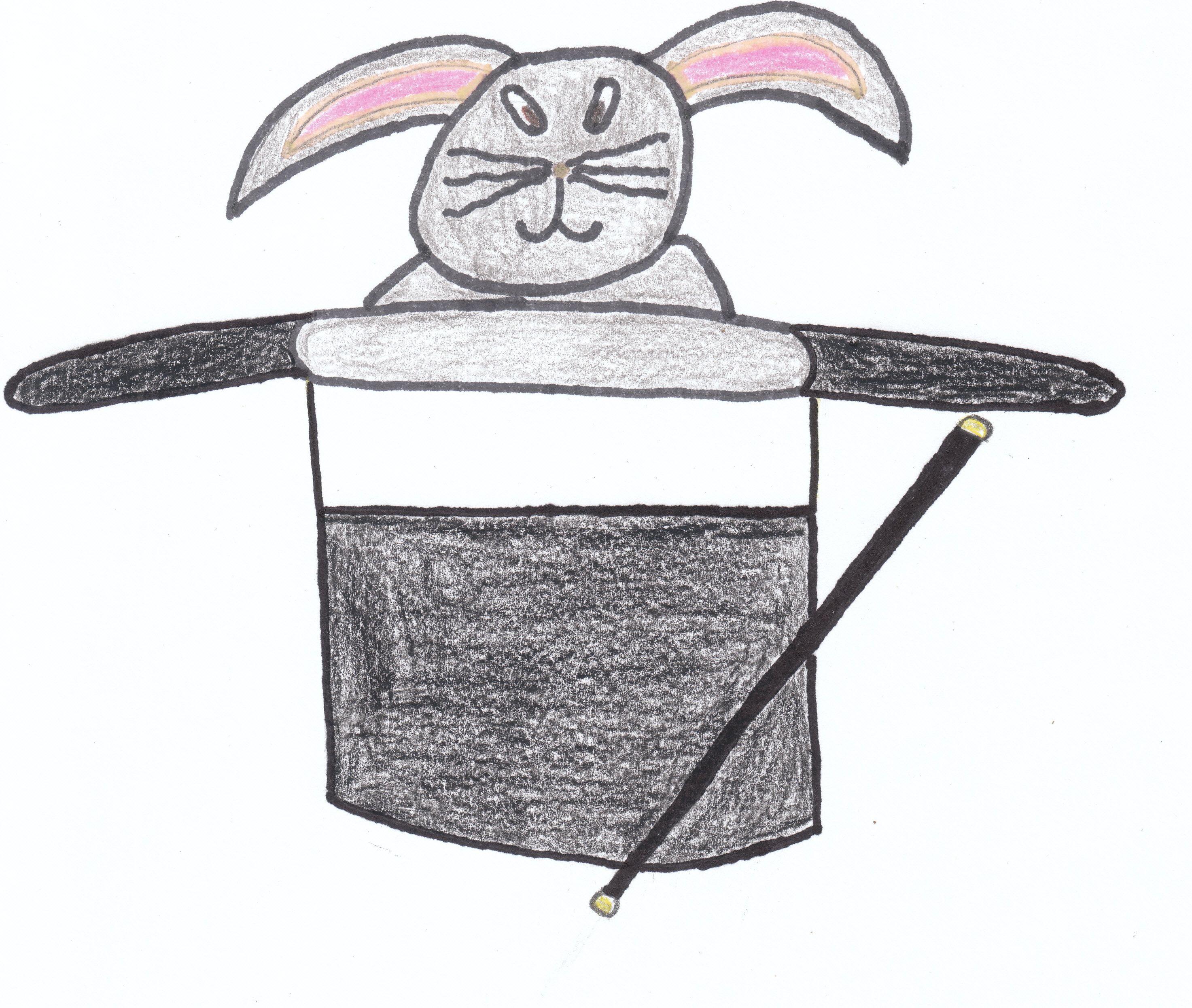
The bidder plays the first card to the first trick. Each other player, in a clockwise rotation, will then play one card to the trick. If the player has a card of the same suit as the card led to the trick he must play it. If he does not have a card of the suit led he must play any trump card from his hand to the trick, if he has one. If he has no cards in the trump suit he may play any card from his hand to the trick. The player who plays the highest trump card to a trick wins the trick. If no trumps were played to the trick, the highest card of the suit led wins the trick. If two cards of the same suit and denomination tie for the win of the trick, the first of the two cards played wins the trick. If a trump card is led to the trick, each player must play a higher trump card in an attempt to win the trick, if they have such a card. The winner of each trick takes the played cards and lays them face down in front of himself. The winner of the trick also leads the first card to the next trick.
Scoring:
After all 15 tricks have been played, the bidder then examines all the cards he has won in tricks (plus the three discarded before the trick taking phase began) to determine if he has enough total points (trick points added to meld points) in the hand to reach or exceed his bid.
The cards captured in tricks by the bidder provide the following point total additions for this player to help him reach his bid:
| Card | Point Value |
|---|
| Ace | 11 |
| Ten | 10 |
| King | 4 |
| Queen | 3 |
| Jack | 2 |
|
|
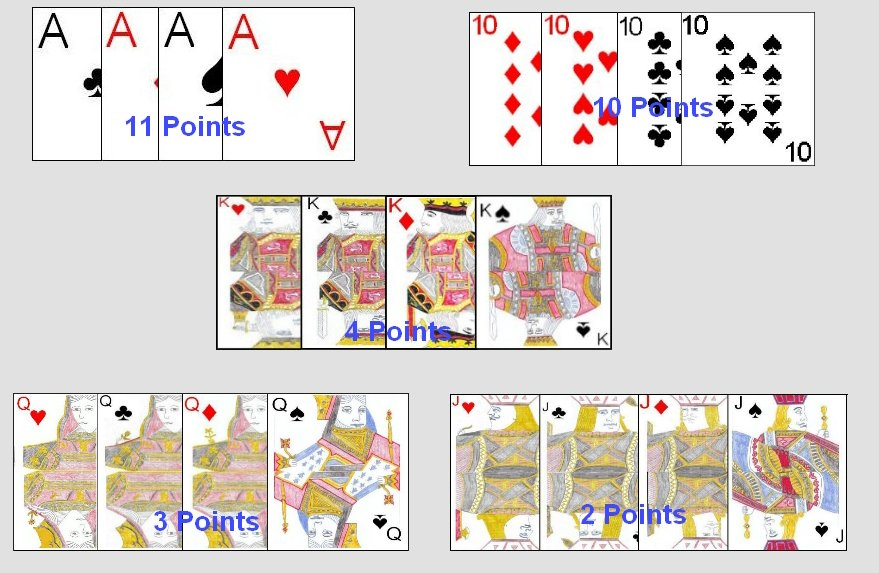 |
Also, winning the last trick of the hand is worth an additional 10 points.
The bidder then totals all his trick points with his meld points. If he has scored enough total points to reach or exceed his bid he is said to have won the hand.
There are a number of methods used to determine the game winner in Auction Pinochle. Often, each hand is considered a complete game. In this case, if the bidder completes his bid he is declared the winner, however if he is unable to complete his bid his opponents are declared the winners.
Another common way is through a number of hands, with the first player to accumulate a total of 1000 points over a series of one or more hands being considered the winner of the game.
Game Points: Whichever method of determining the winner of a game is used, players usually keep a running total of "game points" (separate from the bidding points actually earned during the hand), which are awarded each hand to a player who successfully completes his bid. These game points are often used by groups for keeping a running total of game points for each player over a number of Pinochle games or sessions. The following chart shows the number of game points the bidding player will earn on a particular hand if he is able to fulfill his bid on the hand. The number of such points earned is dependent on the total the player bid during the hand as per the chart.
| Game Points |
|---|
| Bid | Point Score |
|---|
| Under 300 | 5 |
| 300 - 340 | 10 |
| 350 - 390 | 15 |
| 400 - 440 | 25 |
| 450 - 490 | 50 |
| 500 and above | 100 |
Thus, a player winning a hand by fulfilling his bid will earn the appropriate number of game points from the chart for each other player. In other words, if a bidder bid 380 and fulfilled his bid, he would win 15 points per other player in the game (thus he would earn 15 points per each other player in the game for a total of 45 game points).
However, if the bidder does not fulfill his bid, he has been "double bete" and each opponent scores
double the specified number of game points according to the table (according to the bidders bid), with the bidder scoring none for the hand.
If a player concedes (called "bete"), as per the rules above before playing the hand, each opponent earns the listed value (according to the players bid) from the chart .
If the trump suit for the hand was played in spades (♠) all game points scored for the hand are doubled.
Widow Variation: In this variation, which can be played in combination with almost any of the others, the third card of the widow is dealt face up. Thus the widow consists of two face down cards and one card face up. This tends to increase the aggressiveness of the bidding to some degree as all players can see this last card of the widow.
First Bid Requirement: This variation is played identically to the standard version, however the first bidder MUST bid at least 200. Sometimes this minimum bid is increased to 250.
One Bid: This version is also played identically to standard Auction Pinochle. The only difference is in the bidding. In this version, there is only one full round of bidding, with each player having just one opportunity to declare a bid.
If all players pass, the cards are reshuffled and a new hand dealt.
Hoşkin (Xoşkîn): Hoşkin is a card game played in certain areas of Turkey (in particular in the Eastern part of the country). The game is also known under several other names, such as Hosgin, Nazere and Pinîkêr. Hoşkin is designed for play by three and has many similarities to Auction Pinochle. The games uses an 80 card deck which consists of the cards Ace, King, Queen, Jack, and Ace, four in each of the normal four suits. This deck can be created by shuffling together two normal Pinochle decks after removing all cards of rank nine from both decks. The ranking of the cards for trick-taking purposes is as follows (from highest to lowest): Ace, 10, King, Queen, Jack.
After the shuffle and cut, the dealer deals out the cards in a counter-clockwise direction, in face-down packets of five cards, starting with the player at his immediate right. After each player has received a total of 25 such cards, the dealer lays the remaining five cards from the deck face-down near the center of the table.
After each player has then had an opportunity to review their hand, a round of bidding occurs, starting with the player at the right of the dealer (called "Forehand" or "First Hand") and proceeding in a counter-clockwise direction around the table. A bid is the number of total points a player is contracting to win during the hand if permitted to name the trump suit to use for that hand. The minimum bid for the first player is 550 points. If the "Forehand" player passes rather than bidding, the next player at his right ("Mittelhand" or "Second hand") may opt to bid (with the minimum bid he is required to make being 650 points. If this player also elects to pass the Dealer may opt to open the bid with a bid of 750 or higher. Once a player passes, he may look (but not take) the five face-down cards in the center of the table. If all three players initially pass, the cards are shuffled and a new hand is dealt by the next player to the right of the last dealer.
If the Forehand player makes a bid, the second player then must either make a higher bid or pass. All bids should be in multiples of 10. If this second player makes a bid, the Forehand player may then raise his bid or pass. This continues amongst the Forehand and second player until one of them passes. The dealer may then, similarly, make a higher bid or pass, and if he bids, he and the previously highest bidder will continue until one of these players passes. As mentioned, once a player passes he may look at the cards dealt to the center (but ensuring no other player can see them). The player
who eventually makes the highest bid is then set as the "high bidder" for the hand.
This high bidder then announces one of the four suits as the trump suit to be used for the hand. This player then adds the five cards from the middle of the table into his hand.
Each player then announces for and shows for any combinations found in their hands, laying these combinations face-up on the table in front of themself. The following are the allowable melds in Hoşkin:
| Meld Name | Description and Notes | Scoring Value |
|---|
| Non-Trump Bella | One King and one Queen of the same suit (non-trump) |
20 |
| Special Queen/Jack Combination | This is a combination consisting of the Queen of spades and the Jack of diamonds. | 40 |
| Trump Bella | One King and One Queen of the trump suit. | 40 |
| Jack Series | One Jack in each of the four suits. | 40 |
| Queen Series | One Queen in each of the four suits. | 60 |
| King Series | One King in each of the four suits. | 80 |
| Ace Series | One Ace in each of the four suits. | 100 |
| Trump Series | This consists of the Ace, 10, King, Queen, Jack all in the trump suit. The player will also score
an additional 40 points for a Trump Bella. | 110 |
| Complete Series | One Bella in each suit, which is thus one King and one Queens of each suit. | 240 |
| Double Queen/Jack Combination | Two Queens of spades and Two Jacks of diamonds. | 300 |
| Double Jack Series | Two Jacks in each of the four suits. | 400 |
| Double Queen Series | Two Queens in each of the four suits. | 600 |
| Double King Series | Two Kings in each of the four suits. | 800 |
| Double Ace Series | Two Aces in each of the four suits. | 1000 |
| Double Complete Series | Two Bellas in each suit, which is two Kings and two Queens of each suit. | 2400 |
| Quadruple Queen/Jack Combination | Four Queens of spades and Four Jacks of diamonds. | Hoşkin (see below) |
|
|
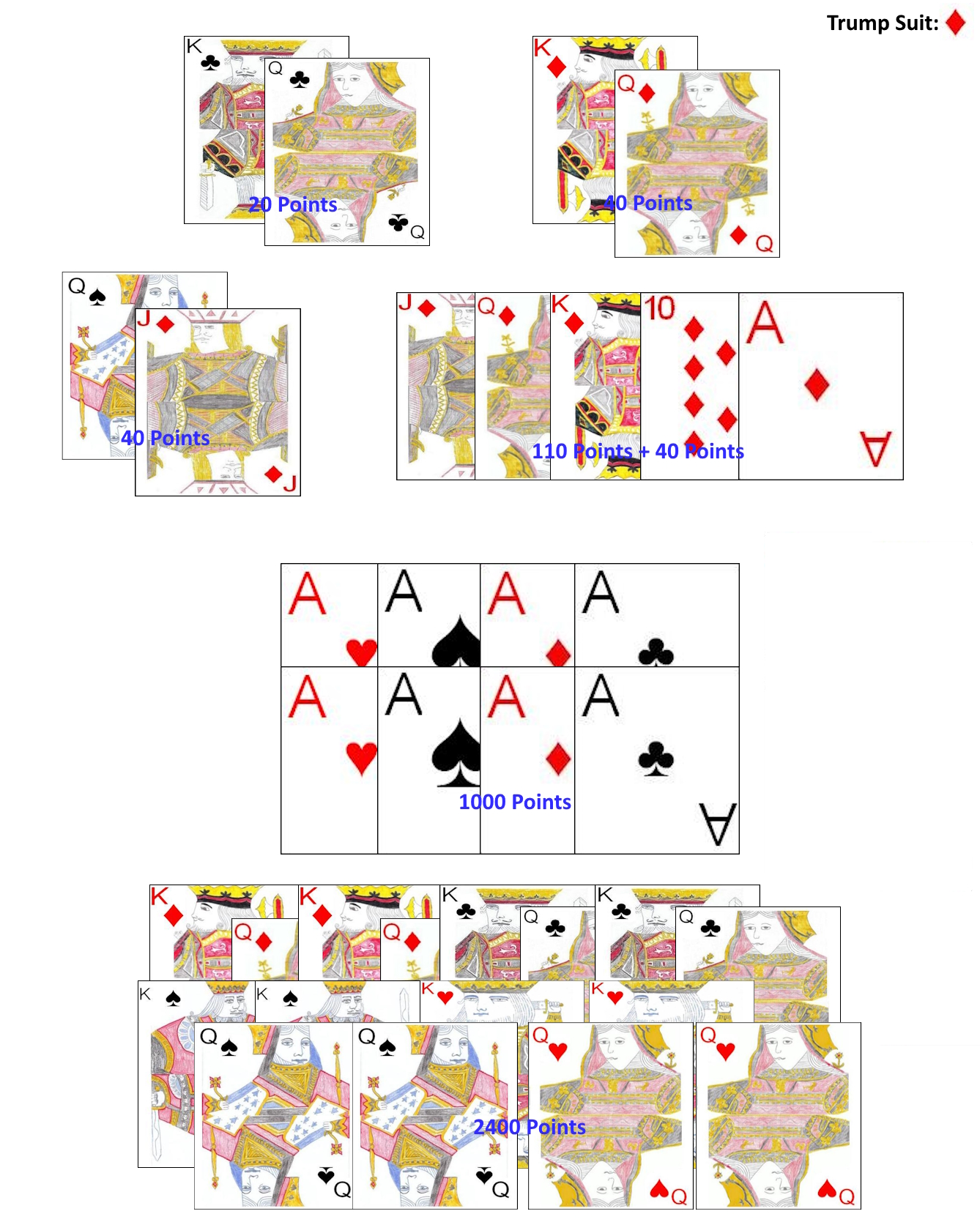 |
If any player manages to have in hand, and thus meld, the Quadruple Queen/Jack combination he immediately wins the entire game unless his score is currently negative (below zero). If he has a negative score, he earns 3500 points for that meld.
The same card can be used to build multiple melds, however a player scoring for any Double Complete series cannot also score for the single series of that same denomination as well.
If the high bidder, after showing his valid combinations, does not believe he can fulfill his bid, he may resign the hand. In this case he earns no points for the hand and the amount of his bid is subtracted from his score. Each opponent scores the amount of their valid melds, as well as a bonus of 100 points.
If the high bidder elects to play, however, he begins by discarding five cards from his hand (to reduce his hand to 25 cards). He may not discard any cards that he used for valid combinations. Each player (including the high bidder) than makes a note of how many points they earned for points during the hand (but does not add them to their score until the end of the hand). The high bidder then plays the first card to start the first trick. Each other player, in a counter-clockwise direction then plays one card of choice to the same trick.
The leader to a trick may play any card of choice to that trick. Each other player must play a card of the same suit to that trick. If the led card was a card in the trump suit, each player must play a card in the trump suit if possible, and must attempt to win the trick if possible. If a card in a non-trump suit is led to the trick, each other player must play a card of the same suit as led to the trick if able, and if having no such cards, they must play a card from the trump suit if the have any (but are not required to play a higher trump suit than any yet played to that trick). If the player has no cards in the led suit and none of the trump suit, they may play any card from their hand.
The trick is won by the highest card of the trump suit found in it (if any). If the trick contains no cards in the trump suit, it is won by the highest card of the suit originally led to the trick. If the highest such card played to the trick is tyed by two or more players, the first of these tyed cards wins the tricks.
Cards won in tricks are set aside and out of play in a face-down pile near the player who won the trick, and the leader of each trick then leads the first card to the next trick.
After all the tricks have been played and won, each player then reviews the cards won in tricks, and earns a score as follows for each card won in tricks during that hand:
| Card | Point Value |
|---|
| Ace | 11 |
| Ten | 10 |
| King | 4 |
| Queen | 3 |
| Jack | 2 |
The winner of the last trick in the game also earns an additional 20 points.
Both opponents of the high bidder than add to their total this number of card points won (and 20 for the last trick if applicable) to their score as well as the total earned from melds during the hand. However, if any player captured zero tricks during the hand, they will earn no points during this hand. After calculating the total, points are rounded to the nearest multiple of ten (6 or higher is rounded up and 5 or lower rounded down) and added to that player's ongoing accumulated score.
If the high bidder manages to total at least as many points as his bid (before rounding), he also adds up all points earned during the hand (after rounding the total) to his current ongoing game score. If he scores fewer total points than his bid, he earns no points for the hand and must instead subtract the amount of his bid from his current ongoing score.
Once any player reaches or exceeds 4555 points, that player is declared the winner of the entire game or match. If a player exceeds this total before rounding down, he is not required to round down and still wins the game. If multiple players exceed 4555, the player with the highest total number of points wins. The winner of the game is then set as the first dealer for the next game.
Partnership Pinochle: This is a version of Pinochle that is played by four players, two against two as partners. Before the game begins each player should cut a card to determine partnerships and the first dealer. The players cutting the two highest cards play as partners against the players cutting the two lowest. The player who draws the highest card is the first dealer, with his partner seated directly across from him. Thus, the order of the play of cards to a trick alternates between the partnerships.
The game is played with the same special 48 card Pinochle deck described for the standard game. The dealer starts by dealing a batch of three cards to the player to his immediate left and continues dealing the groups of three face down cards clockwise around the table to each player. When each other player has 12 cards, and the dealer is about to deal himself his twelfth and last card of the hand, he instead deals his last card face up in front of himself. The suit of this card designates the trump suit for this hand. If this card is a 9 the dealers partnership immediately scores 10 points. If this card is any other card, each player in a clockwise rotation, starting with the player to the dealers left has one opportunity to exchange the 9 of this trump suit (the deece) from his hand for the face up card.
After this, the dealer then takes this card back into his hand (which may have been exchanged for the deece by this time).
In Partnership Pinochle all players may meld with scoring identical to that of standard Auction Pinochle. Each player must meld for himself, however the total scores for the partnerships melds are combined for the partnership. If a player is able to meld certain "double" melds (two full sets of the same legal meld) they receive a higher point value than two regular such melds would score as per the following table:
| Double Meld | Description | Score |
|---|
| Double Flush | 2 Complete sets: A,10,K,Q,J of the trump suit | 1500 |
| Double 100 Aces (8 Aces) | Two Aces in each suit | 1000 |
| Double 80 Kings (8 Kings) | Two Kings in each suit | 800 |
| Double 60 Queens (8 Queens) | Two Queens in each suit | 600 |
| Double 40 Jacks (8 Jacks) | Two Jacks in each suit | 400 |
| Double Pinochle | 2 Queens of spades and 2 Jacks of Diamonds | 300 |
|
|
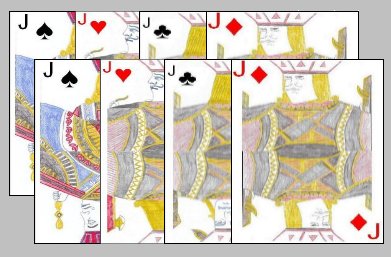 |
Double melds not shown explicitly in this table are worth their basic value doubled (Thus a double royal marriage would earn the player who melds it 80 points). As in most other variations of Pinochle, a specific card that is part of one category may be used in melds of other category, but not in any other melds of the same category.
After the melds have been made, scored and observed by all players, the melds are then gathered back into the respective players hands and the trick taking portion of the hand begins. The player to the dealers left leads to the first trick and the play of the hand is the same as in the standard game. A partnership cannot score any points for the hand if they have not won at least one trick during the hand. The scoring for the individual cards won in tricks is the same as in Auction Pinochle as described above. The partnership scores the total points for all trick points won by either of the partners in the partnership. The first partnership to reach 1000 or more points wins, although this total is sometimes higher for a longer game.
Another often played variation of the scoring in Partnership Pinochle is the determination of the winner if both sides reach or exceed the game total (1000 points or whatever has been decided beforehand for the game) on the same hand. In this case, rather than declaring the higher total the winner (as in normal Partnership Pinochle) the necessary score to win the game is instead increased by 250 points and another hand is dealt. This raising of the score can continue multiple times if both partnerships continue to reach or exceed the new winning total on the same hand.
Partnership Auction Pinochle: This is a version of Partnership Pinochle where the players will bid for the right to name the trump suit. Unlike in standard Partnership Pinochle, no trump card is turned up. Instead, as in standard Auction Pinochle, the players bid. The lowest minimum first bid is 100 and each successive bid must be at least 10 points higher than the last. A player may pass on any of his turns to bid, however once a player passes he may no longer make any bids in this hand. All bids should be made in increments of 10. The player to the dealers immediate left begins the bidding. Once the highest bidder is determined (as in Auction Pinochle) that player then names the trump suit.
At this point all players are then entitled to lay down any possible melds they may hold in their own hands.
The remainder of the game is then played identically to standard Partnership Pinochle, with the player to the dealers immediate left leading the first card to the first trick. The totals of both players (melds and trick points) in a partnership are added together for the final score for determining if the partnership was able to fulfill the bid (match or exceed the number of points bid). A side must win at least one trick in order to generate any score from its melds.
If the "bidding" side wins at least as much as it bid (counting both meld points and trick points) it adds this amount to their total score. If they are unable to score at least as much as their bid, the amount of their bid is subtracted from their currently recorded score (minus scores are possible). The opposing partnership always scores the total amount of any points scored during the hand. The first partnership to score 1000 points wins the game. When adding the scores at the end of the hand, the bidding side is the first to tally their score, so even if the other side might possibly score higher then the bidding side, because the bidding side reached this total first, they are declared the winner.
Partnership Auction Pinochle with Widow: This version is played identically to Partnership Auction Pinochle, however with the addition of a widow hand. Each player is dealt only 11 cards (the last batch distributed would only have 3 cards) and a four card widow is dealt face down to the center of the table. The highest bidder is then entitled to pick up the widow. He then selects one of the cards to add to his own hand and then distributes one each of the remaining three cards face down to each other player.
 Racehorse Partnership Auction Pinochle:
Racehorse Partnership Auction Pinochle:: This variant is also played identically to standard Auction Pinochle, with two exceptions:
- Once the highest bid is determined, that player's partner then exchanges any three cards from his hand face down with his partner.
- The minimum starting bid is 250 points.
Partnership Pinochle for 6 or 8 Players:: This game is played similarly to Partnership Pinochle (any variation) with the exception that the partnerships consist of more players. A six player game would thus consist of two partnerships of three players each and an eight player game would be two partnerships of 4 players each.
The players of a partnership should sit around the table in alternating positions (i.e. Partnership 1 player, partnership 2 player, another partnership 1 player, another partnership 2 player, and so on).
Generally two full Pinochle decks are used, and dealt out 4 cards at a time to each player. The game for 6 should consist of each player receiving a total of 16 cards and in a game for 8, each player should receive a total of 12.
Double Pack Pinochle: This game is played similarly to Partnership Pinochle with the following exceptions:
- The game is played with two special Pinochle decks (as described above) however, from these decks all the nines are removed. Thus there are then 4 cards of each suit of the denominations Ace, King, Queen, Jack and Ten (Total of 80 card deck) using the standard Pinochle ranking (A, 10, K, Q, J) minus the 9's.
- Each player receives 20 cards in the initial deal, dealt in the format described for Auction Pinochle.
- The minimum first bid is 500 points.
- Since the nines have been removed from the deck, all rules and scoring regarding these nines are not used.
As there are four cards of each denomination in each suit for Double Pack Pinochle, double, triple and even quadruple melds are possible. The single melds are scored identically as in Auction Pinochle above. However for double, triple and quadruple melds in this game, use the following chart to determine the scores gained from such melds:
| Meld | Description | Score |
|---|
| Double Flush | 2 Complete sets: A,10,K,Q,J of the trump suit | 300 |
| Triple Flush | 3 Complete sets: A,10,K,Q,J of the trump suit | 450 |
| Quadruple Flush | 4 Complete sets: A,10,K,Q,J of the trump suit | 600 |
| Double Royal Marriage | 2 Kings and 2 Queens of Trump suit | 80 |
| Triple Royal Marriage | 3 Kings and 3 Queens of Trump suit | 120 |
| Quadruple Royal Marriage | 4 Kings and 4 Queens of Trump suit | 160 |
| Double Common Marriage | 2 Kings and 2 Queens of matching non-trump suit | 40 |
| Triple Common Marriage | 3 Kings and 3 Queens of matching non-trump suit | 60 |
| Quadruple Common Marriage | 4 Kings and 4 Queens of matching non-trump suit | 80 |
| Double Aces | 2 Aces of each suit | 1000 |
| Triple Aces | 3 Aces of each suit | 1500 |
| Quadruple Aces | 4 Aces of each suit | 2000 |
| Double Kings | 2 Kings in each suit | 800 |
| Triple Kings | 3 Kings in each suit | 1200 |
| Quadruple Kings | 4 Kings in each suit | 1600 |
| Double Queens | 2 Queens in each suit | 600 |
| Triple Queens | 3 Queens in each suit | 900 |
| Quadruple Queens | 4 Queens in each suit | 1200 |
| Double Jacks | 2 Jacks in each suit | 400 |
| Triple Jacks | 3 Jacks in each suit | 600 |
| Quadruple Jacks | 4 Jacks in each suit | 800 |
| Double Pinochle | 2 Queens of Spades and 2 Jacks of Diamonds | 300 |
| Triple Pinochle | 3 Queens of Spades and 3 Jacks of Diamonds | 450 |
| Quadruple Pinochle | 4 Queens of Spades and 4 Jacks of Diamonds | 3000 |
|
|
|
In Double Deck Pinochle on a players bid, they may also divulge certain information regarding their hand to help their partner. Thus, a player before making his bid, may give basic information regarding his hand such as the following:
- He may indicate he has a long suit (but may not indicate a specific suit)
- He may indicate he has a flush (again, without naming a suit or any other specific information regarding the hand)
In addition before the bidding begins, each player is given one opportunity (in the same order as the bidding will occur) to declare the total score of his possible meld (without giving any specific on the actual type or suit of the cards in the meld). A player is not obligated to do so and can declare a value higher or lower than his actual meld might be. If a player makes a meld announcement after the bidding has begun, this is considered an automatic overcall of the previous bid (whatever it might be) of 10 points for each 100 (or fractional portion of 100) points of his meld score announcement.
At the end of a hand, the "bidding" partnership totals their score first, thus if this partnership reaches or exceeds the required score on the hand, they are declared the winners regardless of what the opponents would have scored on that hand.
In all other aspects this game is played the same as the Partnership Pinochle variation described above.
Two Hand Pinochle: As the name of this variation suggests, this game is for two players. Determination of first dealer is usually by high card drawn from the face down deck. The first dealer deals out 12 cards to each player in groups of three, starting with his opponent. After both players have 12 cards, he then turns over the next card to the center of the table to determine the trump suit for the hand. If this card is a 9, the dealer instantly scores 10 points. He then places the remainder of the deck slightly over this card, face down to form the stock.
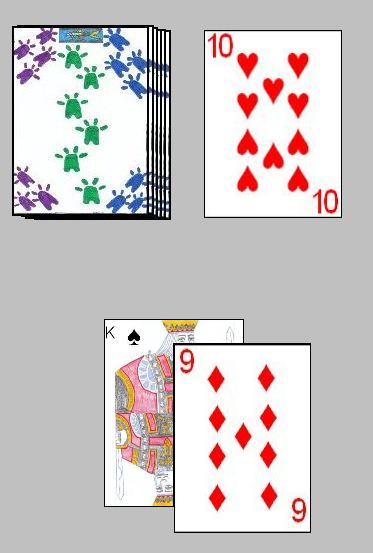
This game is played in two stages. The first stage, called the drawing phase, consists of the playing of the first 12 tricks. During this stage, a player is not required to play a card of the same suit as that led and may play any suit, including trump. The highest trump card played wins the trick. If the trick contains no cards of the trump suit, the highest card of the suit led wins the trick. After a trick is won, the winner of the trick takes these cards and places them in a pile in front of himself. After each trick during this drawing phase, the dealers opponent draws the top card of the stock and the dealer draws the next. The winner of each trick leads to the next.
The winner of a trick may meld one time before drawing a card during this drawing phase. However, he may only make one meld at this time. The one exception to this rule is that the player may meld the deece along with any other meld after winning a trick. A player, after showing and scoring for the deece (10 points) when melding may exchange it for the card exposed to determine trump at the beginning of the hand. Once played, all melds must remain on the table, however a player may play any card from his melds from the table to a trick on his proper turn. As in Auction Pinochle, the player may not use the same card in melds of more than one class. In addition, when making a new meld, the player must add at least one card from his current hand (in other words, he cannot use just cards from his other melds to make another meld).
After the last card of the stock is drawn (after a total of 12 tricks have been played and won), the next stage of the game, called the Play-Off begins. The player drawing the last card from the stock must show this card to his opponent. His opponent then takes the exposed trump card that still remains in the center of the table. Both players then gather in all their unplayed, melded cards back into their hands. The winner of the last trick during the drawing stage leads to the first trick during the play-off stage. During this stage a player must follow suit to the suit led to the trick by his opponent. If unable to follow suit he must trump if able. If the trump suit is led, the player must attempt to win the trick by playing a higher trump suit if he has one. The highest trump card in a trick wins the trick. If no trump suited cards were played to the trick the highest card of the suit led wins the trick. The winner of each trick leads to the next. The players continue in this manner until they have played the last 12 tricks of the hand. Since the stock pile is exhausted, the players do not draw after each trick is played. Additionally, no melds may be made during the play-off stage.
At the end of the hand each player scores for a combination of his melds and his trick points won. The scoring for the melds and trick points is identical to that as in Auction Pinochle. Meld points are added to a players score as they are played to the table and trick points are added to each players at the end of the hand. As in Auction Pinochle, the first player to score 1000 or more points can be considered the winner. If both players reach or exceed 1000 points in the same hand, the score is increased to 1250 points. If again both players reach or exceed 1250 points in the same hand, the score is again increased to 1500. This can continue to happen as long as both players reach at least the minimum score needed for game in that hand.
Sometimes however, this game is played such that each deal is an individual game.
If this game is played to a total score (rather then each hand being a complete game) a player has the privilege at any time of "Declaring Out". If a player declares out the game immediately ends and that players score is computed based on his prior score, melds on this hand and trick points earned so far for this hand. If the player, has in fact reached or exceeded the current game win total, he is immediately declared the winner regardless of what his opponents score might be at that time. If however, after declaring out a player has less than the required points for game, his opponent is instead declared the winner.
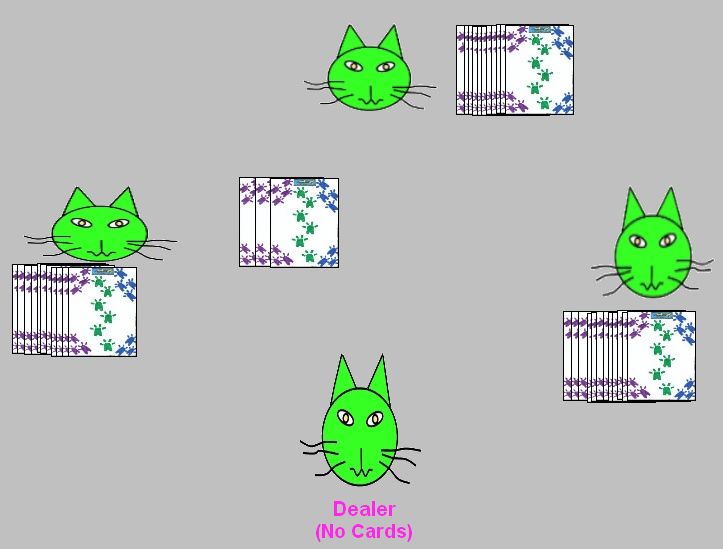 Pinochle for 4 and 5
Pinochle for 4 and 5:
Although Pinochle is a game designed for 3 players, there may be situations where additional players may want to enjoy a few hands.
For an even multiple of 3 participants, multiple tables of Pinochle can be set with 3 players at each game or table. In this case, at the end of a full Pinochle session, the individual from all tables who has the highest total score would be declared the sessions overall winner.
In situations in which there are 4 or 5 players, however, all the players can still be seated at the table. However, some of these players will not receive cards or otherwise participate in the play of a particular hand.
The players would all sit around the table as normal and perform normal procedures to determine the first dealer and seating positions.
Once the first dealer is established, the deal would rotate around the table from player to player as normal in the usual clockwise direction.
Thus, with 4 players at the table, the dealer himself would not receive cards on the hand but the remaining three players at the table would. On the next hand, the deal rotates as normal to the next player in turn. This new dealer would then not receive cards but the dealer from the immediately previous hand would. This rotation of the deal and player not receiving cards on any particular hand would continue in this manner with the dealer not receiving cards on the hand but to the other 3 players getting their normal card allotment.
In a similar way, with 5 players, the dealer would not receive cards nor would the third participant to that dealers left (in a clockwise rotation around the table) for the hand. As the deal rotates around the table, the new dealer and whichever player was seated in the third position to that dealers left would not receive cards on that hand.
Copyright © 2015
CatsAtCards.com. All rights reserved.


 The bidder plays the first card to the first trick. Each other player, in a clockwise rotation, will then play one card to the trick. If the player has a card of the same suit as the card led to the trick he must play it. If he does not have a card of the suit led he must play any trump card from his hand to the trick, if he has one. If he has no cards in the trump suit he may play any card from his hand to the trick. The player who plays the highest trump card to a trick wins the trick. If no trumps were played to the trick, the highest card of the suit led wins the trick. If two cards of the same suit and denomination tie for the win of the trick, the first of the two cards played wins the trick. If a trump card is led to the trick, each player must play a higher trump card in an attempt to win the trick, if they have such a card. The winner of each trick takes the played cards and lays them face down in front of himself. The winner of the trick also leads the first card to the next trick.
The bidder plays the first card to the first trick. Each other player, in a clockwise rotation, will then play one card to the trick. If the player has a card of the same suit as the card led to the trick he must play it. If he does not have a card of the suit led he must play any trump card from his hand to the trick, if he has one. If he has no cards in the trump suit he may play any card from his hand to the trick. The player who plays the highest trump card to a trick wins the trick. If no trumps were played to the trick, the highest card of the suit led wins the trick. If two cards of the same suit and denomination tie for the win of the trick, the first of the two cards played wins the trick. If a trump card is led to the trick, each player must play a higher trump card in an attempt to win the trick, if they have such a card. The winner of each trick takes the played cards and lays them face down in front of himself. The winner of the trick also leads the first card to the next trick.




 This game is played in two stages. The first stage, called the drawing phase, consists of the playing of the first 12 tricks. During this stage, a player is not required to play a card of the same suit as that led and may play any suit, including trump. The highest trump card played wins the trick. If the trick contains no cards of the trump suit, the highest card of the suit led wins the trick. After a trick is won, the winner of the trick takes these cards and places them in a pile in front of himself. After each trick during this drawing phase, the dealers opponent draws the top card of the stock and the dealer draws the next. The winner of each trick leads to the next.
This game is played in two stages. The first stage, called the drawing phase, consists of the playing of the first 12 tricks. During this stage, a player is not required to play a card of the same suit as that led and may play any suit, including trump. The highest trump card played wins the trick. If the trick contains no cards of the trump suit, the highest card of the suit led wins the trick. After a trick is won, the winner of the trick takes these cards and places them in a pile in front of himself. After each trick during this drawing phase, the dealers opponent draws the top card of the stock and the dealer draws the next. The winner of each trick leads to the next.
